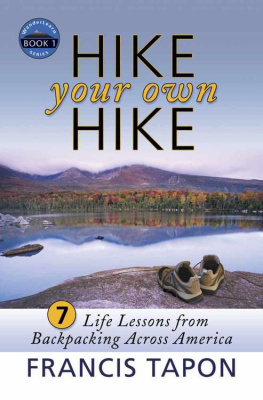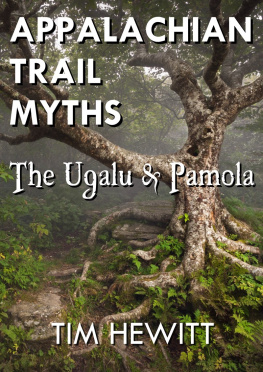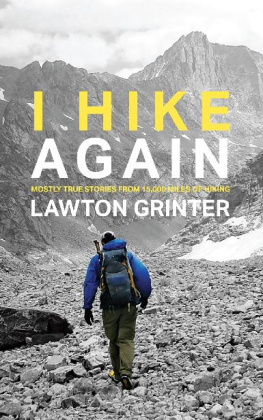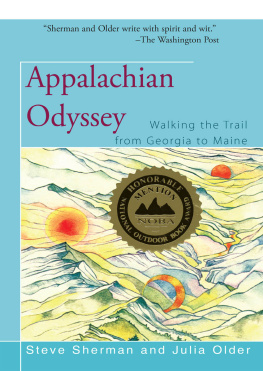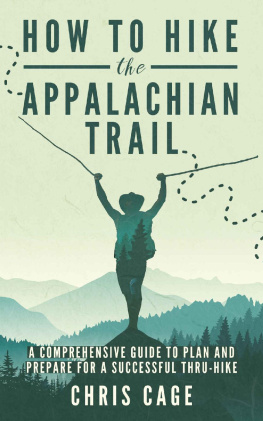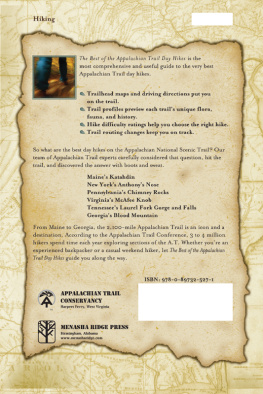Copyright 2011 by Francis Tapon. All rights reserved. No part of this publication may be reproduced, stored in a retrieval system or transmitted in any form or by any means, electronic, mechanical, photocopying, recording, scanning or otherwise, except as permitted under the 1976 United States Copyright Act, without the prior written permission of the Publisher.
Unless noted, all photos in book are Francis Tapon.
Cover photo: Mount Katahdin, Baxter State Park, Maine (photo by Sara Gray/Getty Images).
Limit of Liability: While the Publisher and author have used their best efforts in preparing this book, they make no representations or warranties with respect to the accuracy or completeness of the contents of this book. The advice contained herein may not be suitable for your situation. Consult a professional where appropriate. Neither the publisher nor author shall be liable for any loss of profit or any other damages, including but not limited to special, incidental, consequential, or other damages. In short, please dont sue us.
First published 2006
Second printing 2011
Cataloging-in-Publication Data
Tapon, Francis
Hike your own hike: 7 life lessons from backbacking across America / Francis Tapon p.cm
Includes blibliographical references (p.) and index.
ISBN eBook edition: 978-0-9765812-1-5
1. Self-actualization (Psychology) I. Title.
2. HikingAppalachian Trail.
3. SuccessPsychological aspects.
158.1dc22
Library of Congress Control Number: 2005904842
Visit FrancisTapon.com
Note to the ePub/Kindle edition: The hardcover of Hike Your Own Hike has sidebars, photos with captions, and boxes with quotations. It is a lot of eye candy that you can still enjoy in the PDF version, but its impossible to reproduce that layout in the ePub format. Instead of omitting all the sidebars, weve included them inline with the rest of the text. In an effort to set the sidebars apart from the rest of the text, weve used a different font and centered the sidebars title. However, some eReaders will not display this formatting. If so, dont despair: it should all still make sense. Lastly, weve put most of the photos (and their captions) at that end of the book because putting them inline with the rest of the book would have been too messy in the ePub format. The good news is that several of the photos are now in color! Enjoy!
Introduction
I woke up wondering how a mosquito could have possibly bitten my rear end. I was covered in bites, so I suppose its not incomprehensible that one ingenious insect found its way deep into my pants.
The night before Lisa Garrett, my hiking partner, had agreed that we should camp at the summit of the mountain where the winds were strong enough to drive away the mosquitoes. We carried an 18 ounce tarp instead of a 48 ounce tent, because we didnt expect that many bugs and we were eager to save as much weight as possible. We plopped down without setting up the tarp to admire the sky and to enjoy the brisk winds that kept those infernal insects at bay. We had been hiking almost nonstop since 4:30 a.m., and so when Lisa lay down at 9 p.m. she was asleep in seconds.
I managed to stay awake for two minuteslong enough to see a flash of lightning in the dark sky. I didnt say anything to Lisa. I took a deep breath and prayed it was just my imagination. Thunder rumbled in the distance. I gulped. A minute later I felt a drop of rain explode on my forehead.
Its coming, I mumbled to Lisa, who was as alert as a corpse.
I shook Lisa hard, Lisa, a storm is coming! You gotta get up. We have to set up the tarp. Now!
She woke up in disbelief. When we had been hiking up the mountain there were a few clouds around, but nothing ominous. She couldnt believe that the weather had changed so quickly. As I stumbled out of the sleeping bag, I said dryly, Welcome to Maine.
We pitched the tarp extremely low because with the fierce winds at the summit, the rain would surely come at a nearly horizontal angle. The tarp flapped violently in the blustery weather, but we managed to set it up. We had to crawl to squeeze under it. The tarp was so low that it halted nearly all the wind. Incredibly, within minutes, the mosquitoes descended upon us. Our wind-free environment had become an oasis for these God-forsaken creatures.
I always slept barefoot and with my feet slightly elevated to help decrease the swelling from walking all day. The next morning my exposed feet were swollen for a different reason: they were covered with bites. I couldnt resist scratching them until they bled.
The truly pathetic part was that the storm never hit us. During the night it passed just a few miles north of our campsite and we didnt even get a sprinkle. The token drop that hit my forehead was just a teaser. In other words, we could have slept without the tarp and without the mosquitoes.
While I miserably scratched my butt that morning I wondered, OK, now how is this experience going to possibly help me find the way to get more out of life? I shook my head questioning what I was thinking when I thought backpacking 2,168 miles would bring me some wisdom.
The only difference between a rut and a grave is their dimensions. Ellen Glasgow
Nine months before, I was stuck in a rut. I wasnt wild about my job. But I wasnt sure what to do next. The uncertainty of the future made me addicted to my daily routinesat least they were relatively comfortable. I clung tightly to the known instead of letting go and venturing into the unknown.
Part of my unwillingness to make any drastic changes was that my life really wasnt that bad. Many people struggled much more than I did. Yet deep down inside I realized that I wasnt getting the most out of life and that was bugging me. In short, I was settling for a pretty good life, but not an amazing one.
Lisa was also living on auto-pilot mode. She left behind her hometown in Californias agricultural valley to pursue her dreams in Silicon Valley. However, after six years she was bored with managing commercial properties for the tech companies. Although her intelligence and strong work ethic helped her establish a successful career, she wanted to do something new, but she didnt know what. She also realized that her life was comfortable, but not magical.
It was during this period that we began backpacking. After car camping in the majestic forests of Big Sur, California, we agreed that it would be far more interesting to camp away from all the people. That meant backpacking, which neither of us had done. Our first backpacking trip was a four-day adventure deep into Yosemite National Park, far from the crowds. We were hooked. We started backpacking almost every weekend. Eventually I started investigating some of the longer backpacking trips we could take. It wasnt long before I discovered something called the Appalachian Trail.
The Appalachian Trail (AT) is 2,168 miles long and crosses 14 states on the East Coast between Maine and Georgia. It typically takes six months to traverse the entire trail or thru-hike it. Only about a quarter succeed. To put that into perspective, those who try to summit Mount Everest have a higher success rate (29%). Embarking on a thru-hike usually entails quitting your job, moving out of your home, selling many of your belongings, and convincing your friends and family that you havent gone completely nuts.
Lisa was initially skeptical about thru-hiking the AT. However, she concluded it might help her determine what she should do with her life. After encouraging Lisa to join me, we sold most of our belongings, and I convinced ten companies to sponsor our expedition. I romantically thought that thru-hiking the AT would help me gain profound wisdom. I yearned to uncover the fundamental Principles of getting the most out of life. I theorized that spending several months walking thousands of miles in the wilderness would help me discover these Principles. But while I was inspecting and scratching the dozens of mosquito bites all over my body, I started doubting this theory.
Next page
